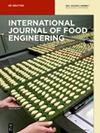基于模型预测温度波动下冷冻食品包装内结霜情况
IF 1.4
4区 农林科学
Q3 FOOD SCIENCE & TECHNOLOGY
引用次数: 0
摘要
食品的冷冻贮藏不仅在行业内被广泛接受,在家庭中也是如此。长期储存过程中的霜冻形成被认为是一种会导致产品特性变化和质量损失的现象。然而,霜冻形成的定量预测和控制仍然是一项挑战。本研究建立了一个数学模型,用于预测家用冰箱中温度波动条件下冷冻食品(即包装在聚偏二氯乙烯(PVDC)薄膜中的冷冻肉糜)内部霜的形成。所提出的模型基于传热和能量平衡方程,并通过冷凝产生的热量来估算结霜量。传热系数是通过实验获得的,并应用于所建立的模型。温度波动的幅度和频率与相应的结霜量之间的相互作用通过等值线图直观地表现出来。结果发现,振幅和频率都会增加结霜量。对于测试的波动范围(温度振幅为 0.5-2.5 K,与压缩机连接时的冷却速度为 0.0125-0.2 K/min),模拟预测包装中的结霜量根据不同的温度波动设置最多可变化约 4.5 倍(对于装有 300 克碎肉的包装,结霜量为 0.48-2.18 克/月)。本文章由计算机程序翻译,如有差异,请以英文原文为准。
Model-based prediction of frost formation inside frozen food packages under temperature fluctuations
Frozen storage of food products is widely accepted not only in the industry but also by households. Frost formation during long-term storage is recognized as a phenomenon that causes changes in product characteristics and quality losses. However, quantitative prediction and control of frost formation remains a challenge. In this study, a mathematical model was developed to predict frost formation inside frozen food products (i.e., frozen minced meat packed in a polyvinylidene chloride (PVDC) film) under fluctuating temperature conditions in a domestic refrigerator. The proposed model is based on heat transfer and energy balance equations, and the amount of frost formation is estimated from the heat generated by condensation. The heat transfer coefficients were experimentally obtained and applied to the developed model. The interactions between the amplitude and frequency of temperature fluctuations and the corresponding amount of frost formation were visualized using contour plots. Both the amplitude and frequency were found to increase frost formation. For the range of fluctuations tested (temperature amplitudes of 0.5–2.5 K and cooling rates of 0.0125–0.2 K/min when connected to the compressor), the simulation predicted that the amount of frost in the packages varied up to approximately 4.5 times (0.48–2.18 g/month for packages containing 300 g of minced meat) depending on the different temperature fluctuation settings.
求助全文
通过发布文献求助,成功后即可免费获取论文全文。
去求助
来源期刊

International Journal of Food Engineering
FOOD SCIENCE & TECHNOLOGY-
CiteScore
2.50
自引率
0.00%
发文量
52
审稿时长
3.5 months
期刊介绍:
International Journal of Food Engineering is devoted to engineering disciplines related to processing foods. The areas of interest include heat, mass transfer and fluid flow in food processing; food microstructure development and characterization; application of artificial intelligence in food engineering research and in industry; food biotechnology; and mathematical modeling and software development for food processing purposes. Authors and editors come from top engineering programs around the world: the U.S., Canada, the U.K., and Western Europe, but also South America, Asia, Africa, and the Middle East.
 求助内容:
求助内容: 应助结果提醒方式:
应助结果提醒方式:


